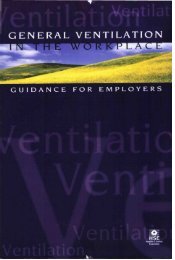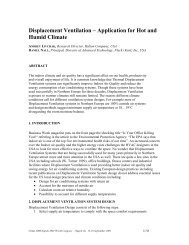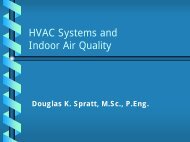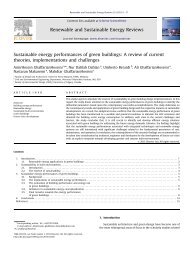Using PIDs for Indoor Air Quality (IAQ) surveys
Using PIDs for Indoor Air Quality (IAQ) surveys
Using PIDs for Indoor Air Quality (IAQ) surveys
You also want an ePaper? Increase the reach of your titles
YUMPU automatically turns print PDFs into web optimized ePapers that Google loves.
Application Note AP-21201/02/CW4. Texts like the NIOSH Pocket Guide to Chemical Hazardshelp you to quickly find the safe levels <strong>for</strong> chemicals.5. PID Correction Factors let users set the scale of the PID tothe chemical of interest so that the reading is accurate.6. <strong>Using</strong> the PID scaled with the right Correction Factor, you canquickly and accurately measure the level of the paint fumes.7. If fumes are at safe levels, the PID can help prove that it is safe<strong>for</strong> the occupants to stay in the building. It might be necessaryto explain the difference between odor threshold and toxicity tobuilding occupants. For example, the odor threshold <strong>for</strong> tolueneis 0.16 to 37 ppm while the 8 hour NIOSH TWA is 100 ppm.8. If the fumes are at unsafe levels, then the PID providesevidence that the building needs to be ventilated.The PID provides a fast and dependable “ruler” so that <strong>IAQ</strong>investigators can measure chemical vapors and quickly makedecisions. In the politically charged situations posed by manyindoor air quality complaints, a fast measurement tool like a PID isinvaluable. It can save time, money and headaches.morning coupled with the high exposure in the afternoon providedan average exposure that was acceptable. However, exposureversus time datalogging with a PID showed that while there wereno VOCs in morning, there were high levels in the afternoon. Byadding the high morning concentrations to the low afternoonconcentrations, adsorptive techniques missed this situation. If wewere to plot the time versus exposure <strong>for</strong> adsorptive tests it wouldjust be a straight line <strong>for</strong> the 8-hour workday.PID PROVIDES INSTANTANEOUS RESPONSE TOTRANSIENT EXPOSURESAdsorbent tubes respond slowly to changes in concentration.This means that they can miss, or grossly underestimate someexposures. For example, suppose a nail salon is located in astorefront under a law office. Odors periodically filter into thelaw office with every new nail salon customer. These transientexposures may affect the law office workers, but the slow responseof adsorptive sampling techniques, coupled with their averaging,would completely miss this exposure. A PID can datalog these quick,high transient responses and help <strong>IAQ</strong> investigators quickly identifyand solve this problem.PIDS IDENTIFY COPIER ODORSA school district had many older photocopies in operation usingliquid toner. The liquid toner had an exposure limit of 100 ppm.Heavy copier use released significant concentrations of toner vaporin the small copier rooms where there was little ventilation. A PIDwas used to initially identify the problem and subsequently to help“tune” the new ventilation system to vent the copier odor awayfrom workers.DATALOGGING PIDS DOCUMENT EXPOSURE VERSUS TIMEAdsorptive tests may show that workers were safe on average overan 8-hour day, yet elevated levels of chemical may be missed by theaveraging effects of adsorptive testing. For example, consider anoffice building with a small print shop in the basement. During thewinter, the building manager decided to save money by decreasingthe amount of outside (“fresh”) air introduced into the HVAC systemso that the air in the building was recirculated. Over the course ofa workday, the solvent vapors from the print shop built up in thebuilding until they reached high levels. Workers in the building didn’tsmell the vapors because they had grown accustomed to them overthe workday (olfactory fatigue). Low print solvent exposure in thePIDS: A MAGNIFYING GLASS FOR <strong>IAQ</strong> “DETECTIVES”<strong>IAQ</strong> investigators need a number of detection technologies to trackdown contaminants. <strong>PIDs</strong> provide <strong>IAQ</strong> investigators with a fast andeffective way of identifying and then quantifying a VOC problem. Ifthe PID shows any reading, then the investigator knows to look <strong>for</strong>VOCs. Once the VOCs are identified, then the PID can be instantlyscaled to that chemical so that the investigator knows at the scenethe exact VOC concentration. This not only saves time <strong>for</strong> the <strong>IAQ</strong>investigator, but it also can prevent a small <strong>IAQ</strong> incident from“blowing up” into a major political incident.For further in<strong>for</strong>mation on how <strong>PIDs</strong> work and how to use them,reference Application Note AP-211: <strong>PIDs</strong> <strong>for</strong> Continuous Monitoringof VOCs.RAE Systems by Honeywell 877-723-2878 raesystems.com 4













